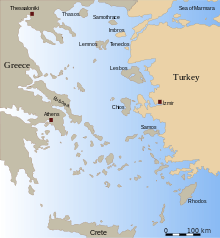Agios Efstratios
| Agios Efstratios Άγιος Ευστράτιος | |
|---|---|
|
Agios Efstratios village | |
 Agios Efstratios | |
|
Location within the region  | |
| Coordinates: 39°31′N 25°00′E / 39.517°N 25.000°ECoordinates: 39°31′N 25°00′E / 39.517°N 25.000°E | |
| Country | Greece |
| Administrative region | North Aegean |
| Regional unit | Lemnos |
| Area | |
| • Municipality | 43.325 km2 (16.728 sq mi) |
| Population (2011)[1] | |
| • Municipality | 270 |
| • Municipality density | 6.2/km2 (16/sq mi) |
| Time zone | EET (UTC+2) |
| • Summer (DST) | EEST (UTC+3) |
| Postal code | 815 00[2] |
| Area code(s) | 2254 |
| Vehicle registration | ΜΗ, ΜΥ |
Agios Efstratios or Saint Eustratius (Greek: Άγιος Ευστράτιος), colloquially Ai Stratis (Greek: Άη Στράτης) is a small Greek island in the northern Aegean Sea about 30 kilometres (19 miles) southwest of Lemnos and 80 kilometres (50 miles) northwest of Lesbos. Together with Lemnos and nearby islets it forms the regional unit of Lemnos, part of the Greek archipelagic region of the North Aegean.
Name
The island was named after Saint Eustratius (Όσιος Ευστράτιος ο Θαυματουργός), who lived on the island in the 9th century as an exile, because he was opposed to the iconoclastic policies of the Byzantine Emperor Leo the Armenian. His grave is still being shown by the inhabitants. The island is mentioned in the Isolario by Cristoforo Buondelmonti in 1420 as Sanstrati. It was known as "Bozbaba" during Ottoman rule.
Geography
Agios Efstratios is quiet, isolated and dry, with a population of approximately 300 people. The climate is arid, with little rainfall during the winter months and long, hot summers. The landscape is mostly rocky, with scarce and low vegetation. Crops are insignificant; the surrounding sea, however, is rich in fish which are fished by local fishermen. There are numerous beaches on the island such as Agios Antonios, Lemonies, Avlakia and others, most of which are reached by caique. Agios Efstratios Island is linked by boat with Limnos, Agios Konstantinos, Kymi and Kavala.
Recent political history
The island was used to house political prisoners in internal exile by the Metaxas Regime in the 1930s. On 19 February 1968, an earthquake (7.1 on the Richter scale) demolished most of the houses,[3] which were replaced by concrete prefabricated buildings laid out in a military-like camp formation. Nonetheless, the island retains a very attractive capital, also called Agios Efstratios, while preserving a rather unspoiled Mediterranean environment with pristine beaches. It is mostly a place for relaxation and meditation. During the Greek military junta of 1967–74, the island was again used as a prison for political dissidents. One of its most famous prisoners was Mikis Theodorakis, political activist and musical composer.
Greece's first green island
Athens News Agency [4] reported that, on 4 June 2009, at a two-day international conference in Athens on "Climate Change and Challenges for the Future Generations"[5] under the patronage of UNESCO, Greece's Development Minister Kostis Hatzidakis said that Agios Efstratios would soon become the country's first "green" island, entirely powered by renewable energy sources (RES), its residents relying on solar and wind generated energy and moving around the island on bicycles and in electric cars. Hatzidakis said a €10 million project would be implemented by 2010. At the same conference Professor Philippos Tsalidis, Development Ministry General Secretary for Research and Technology, said that although Greece's energy needs currently required strategic reliance on natural gas, Aghios Efstratios, could serve as a global model for 100% reliance on RES. Agios Efstratios is included in the European Union's Natura 2000 network of nature protected areas.
Appearance in popular media
Agios Efstratios serves as the basis for the fictional island of Stratis in the 2013 video game Arma 3, along with its northern counterpart of Lemnos, fictionalized as "Altis", the governing body of the two islands. However, "Stratis" in Arma 3 has some critical differences from Agios Efstratios, including numerous additional military bases scattered around the island in-game, and a large airport built off artificial land into the sea south-west of the village of Agios Efstratios.
Gallery
-

View of the harbour of Agios Efstratios
-

Another view of the harbour of Agios Efstratios
References
- ↑ "Απογραφή Πληθυσμού - Κατοικιών 2011. ΜΟΝΙΜΟΣ Πληθυσμός" (in Greek). Hellenic Statistical Authority.
- ↑ "Find a Postcode". Retrieved 2 June 2013.
- ↑ Επίτομο Γεωγραφικό Λεξικό της Ελλάδος (Geographical Dictionary of Greece), Μιχαήλ Σταματελάτος, Φωτεινή Βάμβα-Σταματελάτου, εκδ. Ερμής, ΑΘήνα 2001
- ↑
- ↑ Archived June 8, 2009, at the Wayback Machine.
External links
- Documentary about Agios Efstratios
- Ship Routes to Agios Efstratios
- Municipality of Agios Efstratios Official Page - Δήμος Αγίου Ευστρατίου Επίσημη Ιστοσελίδα
- Agios Efstratios Sea Pilot


